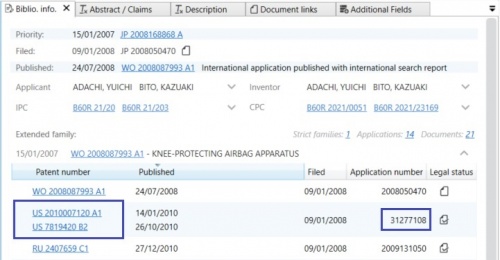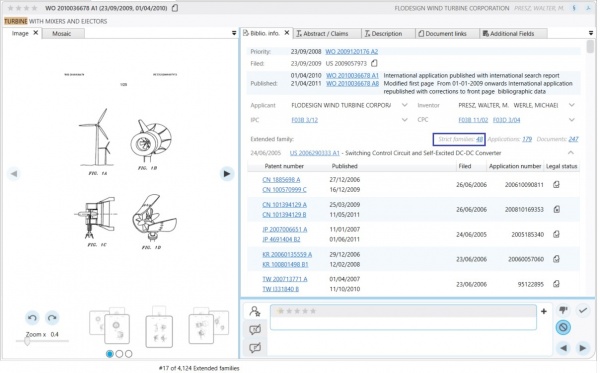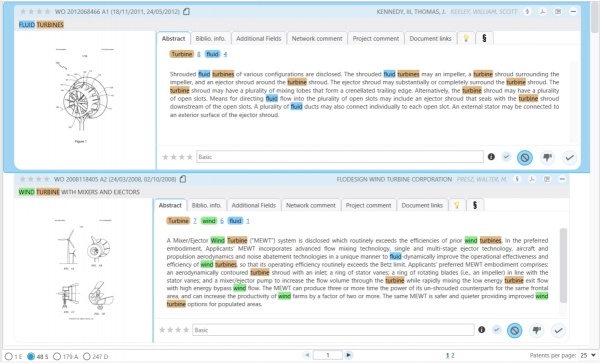EN:Data Content
The IP7 patent database is one of the world’s largest patent databases.
Content
- DOCDB – bibliographic data and texts for more than 100 offices
- INPADOC – Legal status data and patent family information
- OPS und DepatisNet-Interface – Original documents (PDF and figures)
- Full texts are completed by third-party providers
Currently the IP7 database contains full texts for the following countries (CC):
- AT - Austria - Language DE - from 1900
- BE – Belgium - Languages FR, NL - from 1926
- CA – Canada - Languages FR, EN - from 1924
- CH – Switzerland - Languages DE, FR, IT - from 1889
- CY – Cyprus (under construction)
- DE - Germany - Language DE - from 1879
- EP - European Patent Organisation - Languages DE, EN, FR - from 1978
- ES - Spain - Language ES - from 2006
- FR - France - Language FR - from 1980
- GB - United Kingdom - Language EN - from 1894
- HR - Croatia - Language HR - from 1994
- IE - Ireland - Language EN - from 1980
- LU - Luxembourg - Languages DE, EN, FR - from 1980
- MC - Monaco - Language FR - from 1961
- MD - Moldova (under construction)
- PL - Poland - Language PL - from 2006
- PT - Portugal - Language PT - from 2007
- RO - Romania (under construction)
- US - USA - Language EN - from 1976
- WO - World Intellectual Property Organization - Languages AR,DE,EN,ES,FR,JA,KO,PT,RU,ZH - from 1978
Data content European Patent Office:
http://www.epo.org/searching-for-patents/helpful-resources/data/tables/weekly.html
http://www.epo.org/searching-for-patents/technical/patent-additions.html
These websites are regularly updated by the European Patent Office.
Full text extension
This additional data content can be optionally booked to your current service plan.
This extension enables the user to access additional original texts and machine translations in English.
It is possible to search these texts.

The following full texts are available additionally:
Machine translations (English)
- BR - Brazil from 2009
- CN – China from 1986
- DE - Germany from 1987
- DK - Denmark from 1980
- EA - Eurasia Patent Organisation from 1978
- EP - European Patent Organisation from 1978
- ES - Spain from 2004
- FI - Finland from 1980
- FR - France from 1981
- HK - Hong Kong from 2010
- IL - Israel from 1970
- IS - Iceland from 1992
- JP – Japan from 1983
- KR – Korea (South) from 2006
- LU - Luxembourg from 1880
- MX - Mexico from 2014
- NL - Netherlands from 1980
- NO - Norway from 1969
- RU - Russion Federation from 1994
- SE - Sweden from 1980
- SG - Singapur from 2006
- SU - Soviet Union from 1980
- TR - Turkey from 2010 (under construction)
- TW - Taiwan from 1993
- WO from 1978
Original patents with original characters
- AU - Australis from 1987
- BR - Brazil from 2009
- CN – China from 1986
- DK - Denmark from 1980
- EA - Eurasia Patent Organisation from 1978
- FI - Finland from 1980
- HK - Hong Kong from 2010
- IL - Israel from 1970
- IS - Iceland from 1992
- JP – Japan from 1983
- KR – Korea from 2005
- MX - Mexico from 2014
- NL - Netherlands from 1980
- NO - Norway from 1969
- NZ - New Zealand from 2000
- RU - Russian Federation from 1994
- SE - Sweden from 1980
- SU - Soviet Union from 1980
- TR - Turkey from 2010 (under construction)
- TW - Taiwan from 1993
- WO - World Intellectual Property Organization from 1978
Our database is regularly updated with new texts.
Update
Our data content is updated on a weekly basis.
We receive the data on a Thursday and the data is available in our database the following Monday.
Units/Grouping
- The document (D) is equivalent to a published text.
- The application (A) contains all documents of an application.
Example
A and B document: DE 10248531 A1 DE 10248531 B4 Constitutes one application: DE 10248531
In this case the document number does not necessarily have to be the same, e.g. US applications have a different number.
By using the application number, the documents of an application can be detected.

- The strict patent family (S) corresponds to DOCDB simple patent family.
Patent applications with the same technical content.
A simple patent family is a collection of patent documents that are considered to be covering one single invention.
Patent applications that are members of one simple patent family will have all priorities in common with all of the other members.
- The extended patent family (E) corresponds to INPADOC extended patent family.
Patent applications with similar technical content.
Patent applications that are members of an extended patent family will have at least one priority in common with at least one of the other members – either directly or indirectly.
Separating the extended patent families into strict patent families significantly simplifies patent work.
Once a document from a strict patent family was read, the strict patent family can be considered as read. This however, does not apply to the extended patent family.
Example

Extended patent family of: WO 2010036678 A1
Contains strict patent families with similar technical content:
- fluid turbine
- wind turbine
Presentation with further information about the patent families (from minute 4:43)

